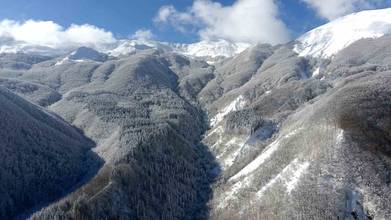
The Beech Forests of Frignano in winter
AIRVŪZ STAFF NOTE :
Check out these excellent drone views of Italy's Apennine Mountains, compliments of AirVuz contributor and pilot Marco Miele. The video was filmed over the Frignano Park near Pievepelago in Modena, one of the central provinces in the Emilia Romagna region. This area sits on a ridge of the Northern Appenine Mountains, which serve as the boundary between Emilia Romagna and the region of Tuscany to its southwest. This area is part of a ridge that includes Mt. Cimone, the highest peak in the Northern Apennines range.
- over 2 years ago
- 2.0k VŪZ
14 




- 16
- Report
The beech forests of Frignano in winter - Province of Modena, Emilia Romagna. January 2023. The name Frignano derives from the ancient inhabitants, the pre-Roman Ligurian Friniates (Friniates), who occupied a much larger territory than the current one and formed the extreme south-eastern part of Liguria on this side of the Apennines. The Friniati settled and settled in the area after they were driven towards the mountains from the Po Valley by the Etruscans and Galli Boi, populations who greatly influenced local customs and traditions. Since the arrival of the Romans, whose occupation the Phryniates tenaciously opposed, there was a progressive penetration of settlers of Roman origin into the villages, which led to a profound and slow agricultural-social transformation and a period of relative peace. The Romans gave the territory its administrative and jurisdictional autonomy so as to constitute a praefectura of the colony of Mutina (Modena). The Friniate community then changed into a Byzantine military structure, governed by a tribunus, who was replaced after the Lombard conquest by a steward: the Arian king Rotari led numerous military campaigns that brought almost all of northern Italy under the dominion of the Lombard kingdom, also conquering Liguria in 643. In the Modena area, Rotari won a crushing victory over the Byzantine exarch of Ravenna Isacio, defeated and killed in the battle of the Panaro river, even if the current Modena and Apennine territories remained Byzantine until the times of the Lombard king Liutprando. In 728 the populations of the Reggio and Modena Apennines rose up against the Byzantine Exarchate of Ravenna for religious reasons and accepted Liutprand as king. The jurisdiction over which he could exercise his exercise retained characteristics of autonomy with respect to the capital. Also the subsequent comitatus Feronianense of the Carolingian age, which was the vast district governed by the count of Modena distinct from the city, maintained this prerogative. The comitatus had as its capital the castrum Feronianum, located near Pavullo. With these foundations, the following were subsequently founded: the Frignano federal municipality (12th-15th centuries), in which all the valley municipalities were represented (excluding those on the hills); the Provincial Council of Frignano in the XV-XVIII centuries; the Este province of Frignano (1832-1859) and, in the Kingdom of Italy, the district and sub-prefecture of Pavullo (1859-1926). The capital was first Sestola, where the Provincial Council had met since the 15th century and the Este governor resided, then, from 1832, Pavullo, where the Este government delegate had settled, and later, the vice-prefect of unified Italy.
Up Next
The beech forests of Frignano in winter

- Marco Miele
- 877 VŪZ
11 - 6
- over 2 years ago
The Castle of Sestola

- Marco Miele
- 1.1k VŪZ
15 - 18
- over 5 years ago
Il Castello di Montecuccolo e il ponte di Olina

- Luca T.
- 1.3k VŪZ
13 - 17
- over 5 years ago
Winter Wonderland

- fly.belarus
- 8.9k VŪZ
61 - 34
- over 8 years ago
The Emilia-Romagna Hills in the Dozza-Imolese Area

- Marco Miele
- 620 VŪZ
12 - 10
- over 6 years ago
Umbria - Passignano sul Trasimeno and surroundings

- Marco Miele
- 1.1k VŪZ
9 - 14
- over 3 years ago
Gradara Castle

- Marco Miele
- 1.1k VŪZ
0 - 0
- almost 4 years ago
San Benedetto del Tronto - Summer 2020

- Marco Miele
- 1.1k VŪZ
8 - 16
- over 4 years ago
Snow Daze

- PNEImagery
- 1.6k VŪZ
1 - 3
- over 2 years ago
Fairytale Winter Forest of Central Russia

- romanblats
- 1.9k VŪZ
13 - 16
- over 5 years ago
